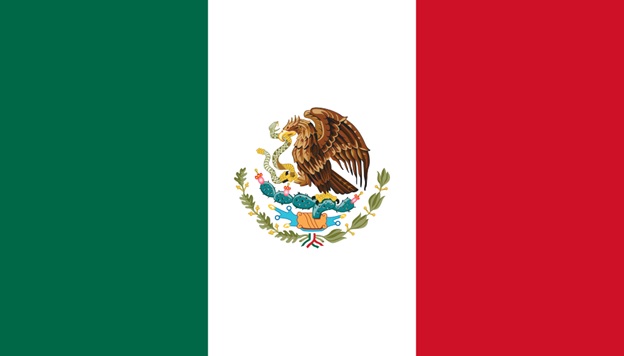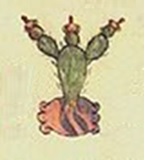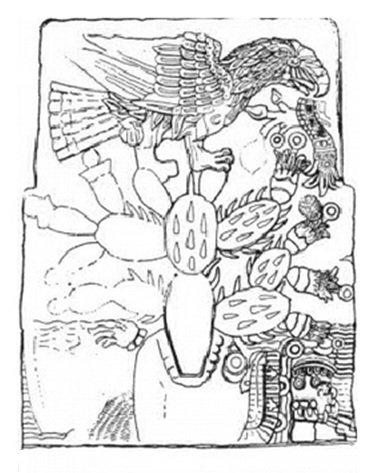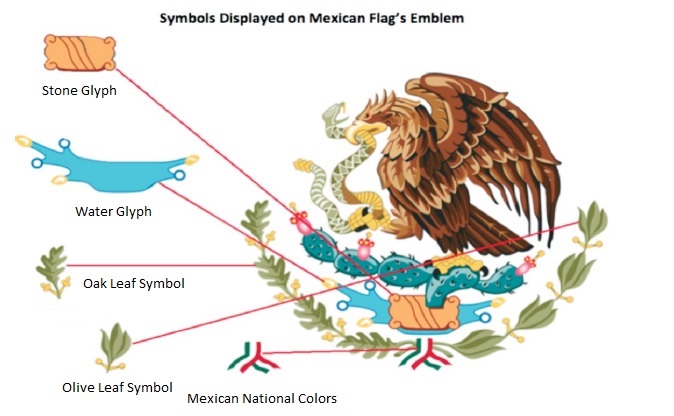An Untold Story of the Mexican Flag: How Do You Spell Tenochtitlan in Aztec

by John M. Hartvigsen
Mexico’s flag is a beloved banner with a history reaching back centuries, but its history is longer and more interesting than people may realize. Although the red, white & green tricolor goes back to 1821, the story of the coat of arms shown on its central white stripe stretch back to precolonial times while relating the story of the legendary founding of Tenochtitlan, the Aztec capital that stood on the site of what is now Mexico City.
The Legend tells of ancient Aztec priests searching for a place to settle where they would find an eagle holding a snake it its talons, perched on a flowering cactus growing from a rock surrounded by water. Whew, what a story. While many know that story, and it is clearly depicted on the flag, there are even more details depicted that have not been easily recognized. English language descriptions of the Mexican flag have not recognized or understood these details.
As I prepared a scholarly paper examining the design of the Mexican flag, I saw symbols that I had not noticed before, and no reference found noted or explained them. Following a great deal of research, I learned that the emblem at the flag’s center includes writing that few may see, recognize or understand. The writing is not in the familiar Latin alphabet or even written in the Spanish language. Rather ancient Aztec glyphs spell out the place name Tenochtitlan and other glyphs name the details shown in the emblem’s design.
Letters of the Latin alphabet have phonetic meaning, and each letter represents a sound or sounds that are used in constructing words. Ancient Aztec writing, on the other hand, used glyphs which were carved or engraved symbols that could be interpreted in three ways:
- Pictograms picture the thing they represent.
- Ideograms express an idea or tell a story.
- Phonograms, like alphabetic letters, represent sounds.

In the story of the founding of Tenochtitlan for example, the glyph for a cactus looks like an actual cactus and is thus a pictogram. Further, its appearance relates to telling a central part of the story, and it is therefore an Ideogram. Finally, the cactus glyph was named and represented the sound nochtli.
The rock glyph, which looks like a little stone pillow at the base of the cactus, had the name and represented the sound te-ti. When the two glyphs are put together they sound out as te-ti nochtli which gave the main sounds of the place name Tenochtitlan and thus was the recognized Aztec glyph for the name of their city. It is, perhaps, more of a rebus than an exact spelling as we would find with the Latin alphabet.
The cactus and the rock in the coat of arms of the Mexican flag, therefore, are:
- Pictograms that they pictorially represent what they are.
- Ideograms that tell part of the story
- Phonograms that sound out enough of the name as to be recognizable.

One other symbol of the design, which tells part of the story is the glyph for water. It looks like a little puddle of blue water with a fringe of shells. The water symbol on the Mexican Coat of Arms found on the flag has the same fringe of shells, which are found on many Aztec illustrations and carvings.

While the eagle and snake are not Aztec glyphs in the strict sense, they are pictograms and ideograms repeated regularly in the Aztec culture. The carving in the stone of Tizoc, as one example, tells the same story depicted on the Mexican flag. The Aztecs loved to tell the story, and modern day Mexicans continue the tradition.

For more information see: John M. Hartvigsen, “The Aztec Heritage of the Mexican Flag,” Flag Research Quarterly, September 2017, No. 14, pp. 1, 3-16.
